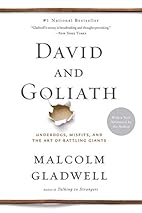David and Goliath: Underdogs, Misfits, and the Art of Battling Giants by Malcolm Gladwell, 7 h
Does any one do popular science and narrative nonfiction better than Gladwell? I've read several books - Blink, The Tipping Point, and listened to most of What the Dog Saw. Gladwell narrates his own book, and he does a great job.
The basic thesis here is that in the *David and Goliath battle, we see David as the underdog. But Gladwell argues that we mostly misunderstand what we think an advantage or disadvantage is. He kept referring to a U-shaped graph, which is just a parabola and he could have used that big science word after describing what it was.
The examples he uses for his analogies are great and he can use them to continually demonstrate his point. For example, most teachers agree that smaller class sizes are better. (I definitely agree!) However, does this work continually? That is, if 25 is better than 32, and 18 is better than 25, is 12 even better? And I can tell you anecdotally that it is not better. Small is good, but there is such a thing as too small. Not enough variety of voices, difficult discussions, no place to hide, and because they students get to know each other so well, they can bicker like siblings, knowing exactly how to push each other's buttons. (although the correcting does become easier) Hence, the idea of a parabola. Pardon me, a U-shaped graph. So, immediately I got his point and was with him for the ride!
Other examples of the U-shaped curve are described. In terms of advantages and disadvantages, he uses an example of people with dyslexia and how there are a good number of extremely successful people who had dyslexia. Because of the struggles (disadvantages) they faced in school, they developed strategies to overcome this. And these strategies become their advantages.
His theories are easy to follow, and I like learning with analogies. I am always trying to find analogies to explain concepts to my classes. I think I am pretty good at it too. Here's a quick one: Gravitational mass and inertial mass are two different ideas of describing mass. However, Einstein proved that they are fundamentally the same thing. Just like I have different names in different places - Mom at home, Mrs MacAulay in the classroom, and Liz in the staffroom. And in each place, I have a different role. But I am still the same person even if I do different things in different places with different names.
Northern Ireland, California's three strikes rule, basketball strategies, and cancer researchers are just some of the situations Gladwell uses to demonstrate his point of how underdogs turn their supposed disadvantages into their advantages.
*David: Did you know that the statue of David in Florence was given to the city by Michaelangelo to represent the little guys against the tyranny of the local government? That David statue is the same David from David and Goliath. I didn't know that until I saw the statue in Italy.

No comments:
Post a Comment
Thanks for commenting, so nice of you to visit.
(I'll try without the letters for a while - so please dont be a spammer! Let's try no anonymous users)